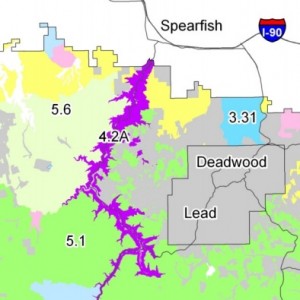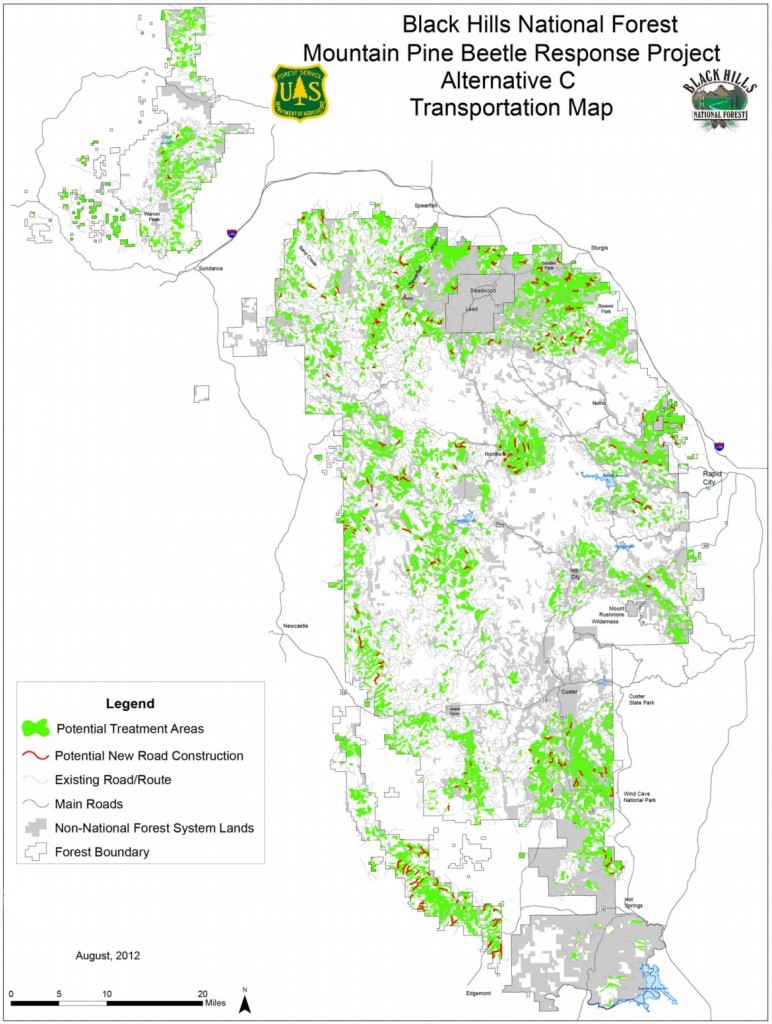The U.S. Forest Service released its final Environmental Impact Statement for its Mountain Pine Beetle Response project Thursday. The current decade-plus pine beetle infestation has killed trees on a third of the 1.2 million acres of the Black Hills National Forest. The EIS leads forest supervisor Craig Bobzien to the conclusion that the best course of action is to treat recently infected trees on 248,000 "high risk" acres. "Treatment" is a combination of cutting trees down, applying insecticide to infested areas, and using "semiochemicals," pheromones that either attract or repel bugs.

After taking public comment, the Forest Service made three main modifications to its proposed plan:
- More landscape level thinning in advance of beetle infestation;
- Add treatments in Spearfish Canyon (Management Area 4.2A);
- More forest roads: 60 miles permanent, 160 miles temporary.
Several Spearfish Canyon residents, the Cooper's mountainsnails, would have kept the road graders, loggers, and sprayers out of the canyon. Cooper's mountainsnail is a sensitive species protected by Forest Plan Standard 3013. The Forest Service will thus amend 3013 to exempt the pine beetle project (but not other activities, including your four-wheeler) from that rule.
Below is a big map of the potential treatment areas for the Forest Service's preferred alternative, as well as where those new roads would be cut into the Hills:

The individuals and organizations who filed comments on the scoping or Draft EIS now have 30 days to submit objections (see the DEIS public comment here). Then the Forest Service will fire up the graders and chainsaws for a project that will take five to seven years.

Please make at least 2 comments: 1) no new permanent roads - the FS cannot maintain those they already have; permanent roads further fragment habitat which in turn is scientifically shown to reduce the occurrence of elk and mule deer within up to one-half mile of either side of the road; and 2) the BHNF has about the highest road density of any NF. Look at a FS map and you'll see that it is almost impossible in the BHNF to be anywhere that is more than 1 mile from a road. It is very hard to be anywhere that is more than one-half mile from a road - even in the special habitat, etc., management areas.
That area got quite a bit worse over the last 2 years. Still not nearly as bad as the southern hills though. I still believe its a losing fight though, but it would be political suicide to publicly state that
interesting that one FS historian said the pine beetle came to the Hills in 1890: that is about ten years after Seth Bullock's migration from the Helena Valley (where the bug has killed 100% of ponderosa pine today) to Deadwood.
If the bug was introduced by hairy fellow friendly to progressive types to the point of building an obelisk in honor of the first RINO, then the bug should be eliminated as a non native species of bug.
Cut trees, kill kitties, and build roads!
But back off Minnesota ridge, there looks to be too much bug cutting and road making there.
I agree with John that the Hills already have more roads than are healthy. I would think that prescribed burns would reduce the need for all those new logging truck roads. However, on p. 48, the Forest Services nixes that idea, since there wouldn't be commercial benefit, and since the forest is so infested with housing that fires are too risky:
"An alternative was proposed that would reduce MPB effects through non-commercial treatments only, use prescribed fire, and convert stands to aspen or birch. The ID Team determined that the use of non-commercial thinning only would focus on limiting tree removal to those smaller than 9-inch diameter is neither warranted nor prudent relative to the on-going MPB epidemic and reducing hazardous fuels within the potential treatment areas. This proposed alternative would be very costly with little to no offsetting revenues. Promoting diversity in forest types is a Forest Plan objective that would continue under any alternative.
"Many of the stand boundaries identified in the project are mid-slope and do not lend to a safe and effective prescribe broadcast burn unit. There is abundant intermix of private land, 56 at risk communities, WUI, FRCC 3, and the potential treatment areas rated as high or very high fire hazard. This increases the burning complexity (in both igniting and holding) therefore, prescribed broadcast burning, utilizing only non-commercial treatments and converting stands was considered by eliminated from detail study."
Cory lets get the govt out of there how come those republicans want Govt involved I thought they were against govt.
Fair point, M! I wonder if the Republicans would prefer to take the Betty Olson approach and have the federal government sell the entire forest.
Selling the BHNF to the tribes for a dollar and good consideration? Works for me, Cory.
Dig deep, cut fast, and bulldoze wide. Turtle island was meant to be mined.
I can live with MPB much easier than the new expanded Deadwod Standard run by "Experts" destroying the remaining 1584 species of plants there.